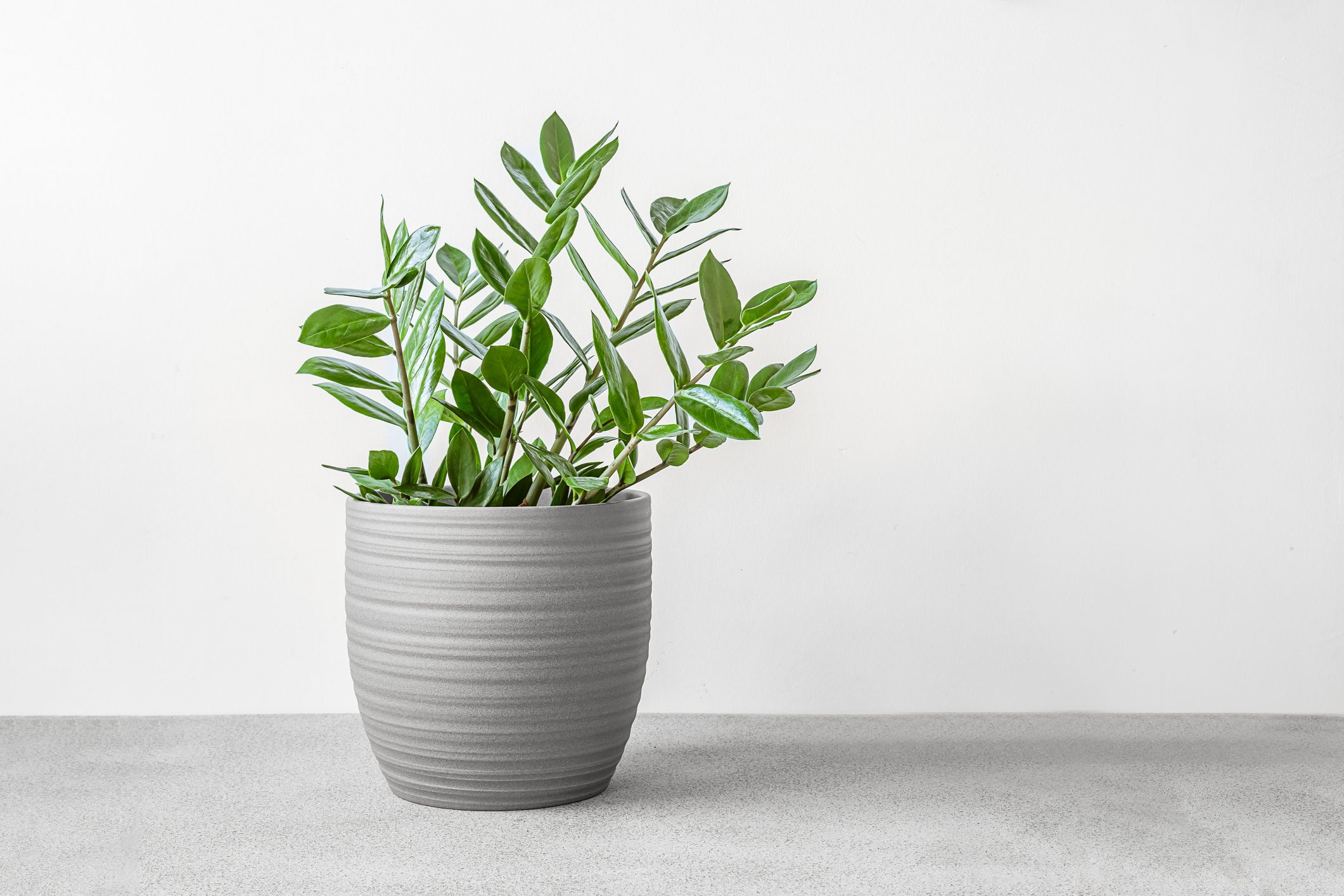ZZ plants are low-maintenance and look great even in less-than-ideal light conditions, making them a great option for beginner houseplant owners.

ZZ Plant Care and Growing Guide


- Common name: ZZ Plant or Zanzibar Gem
- Scientific name: Zamioculcas zamiifolia
- Light needs: Bright indirect light but tolerates low light
- Water needs: Allow soil to dry completely between thorough watering
- Soil type: Well-draining potting mix, such as all-purpose or cactus soil
- Size: 15 to 36 inches tall
Although Zzs are in their name, don’t sleep on this houseplant. With their ability to survive in low-light as well as drought conditions, ZZ plants don’t ask for much TLC. They’re a great first plant for anyone who’s houseplant-curious or who worries they have a black thumb.
And even if you’re a houseplant expert, ZZ plants have something to offer your home as well. Tovah Martin, the author of The Unexpected Houseplant, says, “ZZ plants aren’t going to steal the show, which makes them a good choice for someone who wants an elegant but not dramatic houseplant.”
On This Page
ZZ Plant Varieties

There are several ZZ plant varieties that are easy to find in most garden stores but also bring something visually different to the table. What’s convenient about ZZ plant varieties is that most if not all of them don’t ask for any different care than the standard ZZ plant.
Perhaps the most popular is the Raven ZZ plant. Its dark purple, almost-black foliage create a gothic contrast with any other greenery nearby. Meanwhile, the Chameleon ZZ plant shifts colors with fresh lime green leaves that eventually mature into a deeper green. And Zenzi ZZ plants are a more compact, dwarf variety, topping out at around 12 inches tall. They look great on a desk or other small surface.
How to Propagate ZZ Plants
Tovah says, “The most straightforward way to propagate is by dividing the plant.” In her book, The Indestructible Houseplant, Tovah notes that ZZ plants are very slow-growing, only putting out a new leaf every now and then. So although it can also be propagated through a leaf cutting, it is a time-consuming method.
To propagate, carefully remove the ZZ plant from its container. Using a sanitized knife or simply your hands, separate the plant, making sure each new plant has roots. (ZZ plant roots also have rhizomes: thick, potato-shaped underground stems that store water and nutrients.) Wear gloves while dividing ZZ plants to avoid skin irritation.
An additional consideration is that some varieties may be prohibited from propagation, meaning that a specific variety is still under patent.
Are ZZ Plants Toxic to Pets?
Because they contain calcium oxalate crystals, ZZ plants are toxic to cats, dogs and humans alike. Those crystals can cause mild irritation to the skin via the ZZ plant’s sap, so if you’re handling one of these plants, you should wear gloves as a precaution. If any part of the plant is ingested, it can create adverse reactions, such as drooling, nausea and vomiting.
Yellow Leaves on ZZ Plants

What does it mean when the glossy green leaves of your ZZ plant turn yellow? The most likely culprit is overwatering. A first good step is moving your ZZ plant to a sunnier spot to dry the soil out faster. Tovah recommends bright, indirect light in an east- or west-facing window.
Allow your ZZ plant’s soil to completely dry out before watering it again. (This might mean you only water your ZZ plant once every three weeks.) It should also be planted in a container with drainage holes. Pour off excess water that collects in the saucer.
If you notice your ZZ plant is still producing yellow leaves, you may have a case of root rot on your hands. Check for root rot by removing the plant from the container and seeing if the roots themselves are mushy or have a bad smell. Loosen the soil, remove the rotted roots and repot with a better draining potting mix, such as a cactus mix or an all-purpose potting mix that contains orchid bark or perlite.
Plants exposed to cold drafts or chilly conditions can also develop yellow leaves. Move the palnt away from the drafty windy or to a warmer spot in your home.
Repotting ZZ Plants

“It’s time to repot when you notice that the roots are growing out of the container,” Tovah says. This can mean either the roots are sticking out through the drainage holes at the bottom or the rhizomes are making an appearance through the top soil.
Repotting a ZZ plant is the same process as repotting other houseplants. Select a container that’s about one to two inches bigger. Carefully remove the ZZ plant, keeping roots intact, and repot snugly in the slightly larger container. Besides choosing a container with good drainage (a must for these plants), Tovah recommends using a glazed container to visually play up the shininess of the leaves.
About the Expert
Award-winning writer and plant pro Tovah Martin is the author of The Indestructible Houseplant, The Unexpected Houseplant and, most recently, The Garden in Every Season. There are more than 200 houseplants in her home.
Sources
- The Indestructible Houseplant by Tovah Martin
- DK Grow: Houseplants
- Houseplants for All: How to Fill Any Home with Happy Plants by Danae Horst
- Costa Farms – ZZ plant
- University of Connecticut Home and Garden Education Center – ZZ plant
- Kiwi Nurseries – The Ultimate Guide to ZZ Plants
- Lively Root – The Essential ZZ Plant Care, Growth, and Safety Tips for Beginners





















